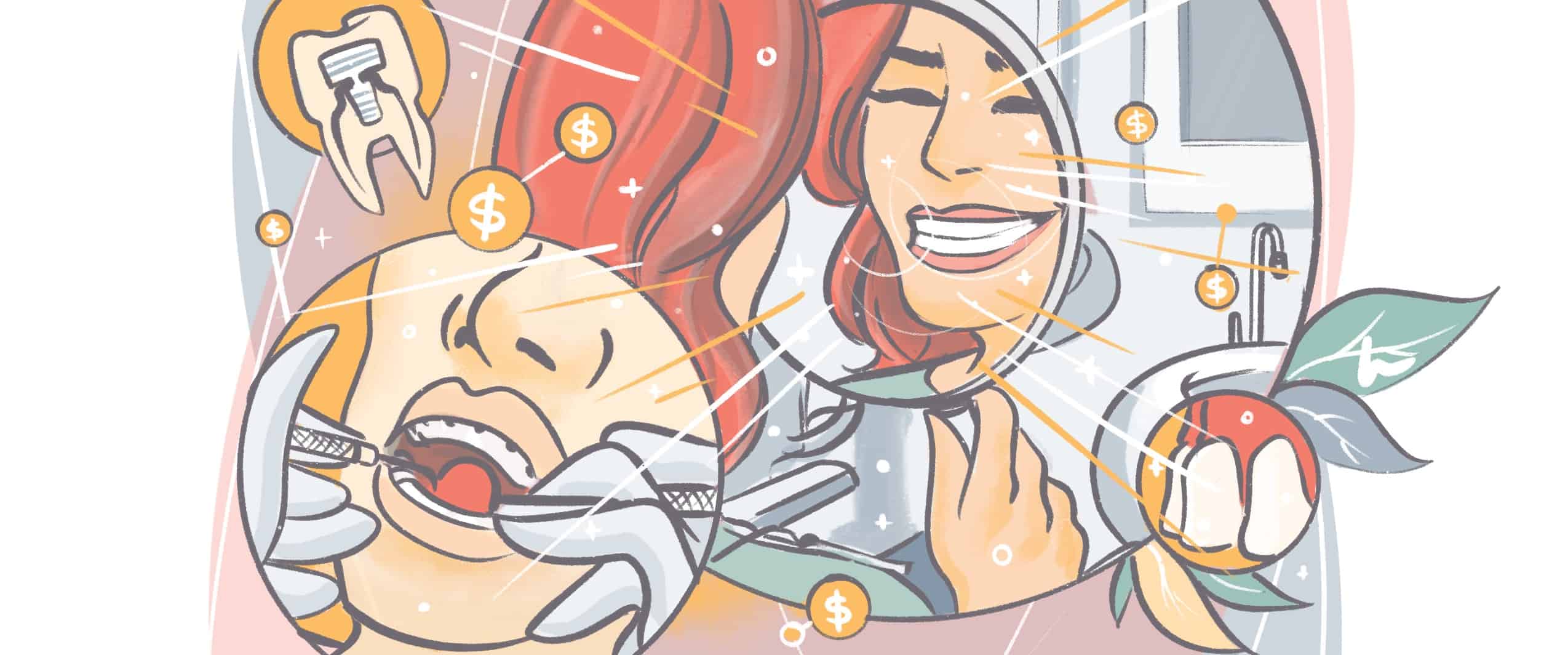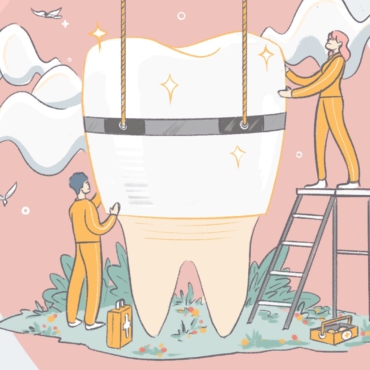Wondering how much do fillings cost, with insurance or without it? No matter how old you are, the mere thought of a toothache (and its consequences) can send chills down your spine.
But let’s be honest, the problems that come with a toothache aren’t just pain-related. Some dental treatments can come with a hefty price tag too. It might even be heftier for those who don’t have dental insurance. Let’s discuss.
What is a cavity filling?
In many cases, the pain and sensitivity felt in a tooth are due to a cavity. That means you’ll probably need a filling.
A cavity is a decayed portion of a tooth. A dentist will need to remove the decayed part with a drill, air abrasion instrument, or laser. The type of instrument depends on the location of the cavity, the extent of the decay, and the dentist’s expertise.
Once the dentist removes the cavity, he ensures the area is clean and free of debris or bacteria. Space is then filled with a protective material, known as a filling.
Fillings are considered a “basic restorative service”. It’s important to make sure you don’t skip a filling. Your cavity or tooth decay can and will get worse with time. If that decay reaches the nerve endings in your teeth, the pain will worsen significantly and the treatment becomes more complicated, painful, and expensive. Don’t wait to fill your cavities.
Not sure if you need a filling? The best thing that you can do is consult a dentist. Your dentist can prescribe an appropriate treatment plan for your issue.
Need a filling?
Get $50 when you book your dentist appointment through Opencare.
Is the cost of a filling covered by dental insurance?
Fillings are a standard service covered by most dental insurance plans. Like other types of health coverage, dental insurance benefits vary by plan and insurance company. For more detail on coverage, be sure to always check the plan benefits documents or ask your insurance provider.
Preventive care such as routine cleanings are usually covered without out-of-pocket costs. Dental cleanings (up to 2) are usually covered by your insurance (depending on your annual maximum).
Most plans typically cover 80% of the costs for certain procedures, including fillings. This cost applies after the annual deductible is met, which also varies by plan.
What types of fillings are there?
There are several types of fillings, each with a different purpose and price.
How much does a tooth filling cost?
There are many factors that can impact the cost. Below is a general guide for your average range, but cost can vary depending on your insurance plan and your treatment required.
| Type of Filling | Average Cost (depends on insurance plan) |
| Silver fillings | Between $50 and $200 |
| Gold fillings | Between $300 and $1000 |
| Composite resin | Between $175 and $250 |
Silver fillings cost
Silver fillings are also known as amalgams or metal fillings. They’re made from combining metals like silver, zinc, mercury, copper, and tin. A silver filling is quite durable and will last you 10 to 15 years when taken care of properly. This is better than the composite (tooth-colored) fillings.
Amalgams are typically less popular than other kinds of dental fillings. Their silver color doesn’t match tooth, making them more noticeable. Also, they require more space within the tooth to be secured properly. That means there’s a chance the metal filling may expand, causing the tooth to fracture.
However, it’s also the cheapest of all dental filling materials, meaning it’s a good choice for those on a tight budget. If you have dental insurance, amalgams can cost anywhere between $50 to $200 for one or two surfaces to repair. And of course, more surfaces will mean the cost will increase.
As for without insurance, these fillings start at about $150 and upwards, depending upon how much restoration work your dentist has to perform on the tooth.
Some patients may worry about the presence of mercury in amalgams. Rest assured the FDA considers these options safe for adults and children above the age of 6. Just remember that a small percentage of people (about 1%) have allergic reactions to mercury in silver fillings.
Gold fillings cost
Gold fillings are one of the most durable types of fillings, often lasting up to several decades. Though gold fillings still hold a cosmetic appeal to some people, they are less common these days. And of course, because they’re GOLD, they’re expensive. Further, it’s rare you’ll find a dentist that offers gold fillings.
Gold fillings can cost between $300 and $1,000 for one or two surfaces. Three or more surfaces will cost you $450 to $1,800. And patients without dental insurance can expect to pay up to $4,500.
Besides the price, some dentists discourage gold fillings if they’re installed directly beside a silver one. That’s because their proximity may cause a galvanic shock. This happens when an electric current forms due to the interaction of both metals and saliva. Not a great feeling.
Composite resin
A composite filling consists of a material that combines plastic and fine glass particles. Composites are a popular choice due to their matched color to teeth, making them an ideal option for front teeth or other visible surfaces.
More importantly, composite resin bonds better to teeth. Dentists prefer to use it to repair chipped, broken, or worn teeth. And, the dentist removes less of the tooth structure to prepare the site for the filling.
On average, composite fillings last about five years, and with proper care, up to 15 years. If you have dental insurance, a composite filling can cost almost $200. Without insurance, you’re looking at about $250 to cover one or two surfaces. (And up to $450 for a filling that covers three or more surfaces).
There are other dental filling materials such as ceramic and glass ionomer some dentists also use. Each comes with a different price range. Generally speaking, ceramic fillings are almost as expensive as gold ones. On the other hand, glass ionomers are comparative to composite resin.
Need a filling?
Get $50 when you book your dentist appointment through Opencare.
Why do dentists recommend different types of fillings?
Typically, a dentist will recommend the best dental filling material for you. However, you must understand that fillings are not only limited to treating cavities. A dentist may use them to repair a cracked or broken tooth as well. Depending on the type of treatment, a dentist will select the right kind of material for the filling.
However, there are additional factors that determine the type of material your dentist will use, such as location of the cavity, extent of the decay, the cost of the material, and whether or not you have insurance.
What factors influence cost?
First and foremost, find a dentist who accepts your insurance. Dental insurance plans can cover the partial cost of your fillings or fully cover your care. But you’ll need to pay the deductible before the insurance company covers the agreed amount.
Some factors that can impact the cost of fillings include:
- The number of cavities you have
- The size of your cavities
- Which teeth need filling. (Molars may require extra effort.)
- The material used
- Where you live. (It’s true, some cities will be more expensive than others.)
- And any additional treatments like anesthesia, root canal, or gum infection treatment
Should I just have this tooth pulled?
It’s always best to try and preserve the original tooth. Extractions are typically a good idea only if the tooth is too diseased, too weak, or too far decayed to save it. The filling will not make the tooth better.
While an extraction may seem cheaper than a filling, you must remember the dentist will have to replace it. An implant costs more time and money than a small filling done at the right time.
Final thoughts
At the end of the day, it all comes down to preventative measures. For instance, visiting a dentist regularly can help detect cavities earlier on. A simple filling is considerably cheaper than other treatments such as a root canal.
Most dental insurance plans typically cover 80% of the costs for certain procedures, including fillings. This cost applies after the annual deductible is met, which also varies by plan.
Due for a checkup?
Find a top rated dentist near you that takes your insurance.
However, if you ignore oral health and only go to a dentist when a problem arises, you can expect an extreme situation. That small cavity progresses until the only course of treatment is a root canal, or worse, extracted and replaced with an implant.
Don’t let your negligence cause the cost of your dental bills to increase. It’s time to visit a dentist near you. After all, you want to save your original tooth and preserve that beautiful smile.








